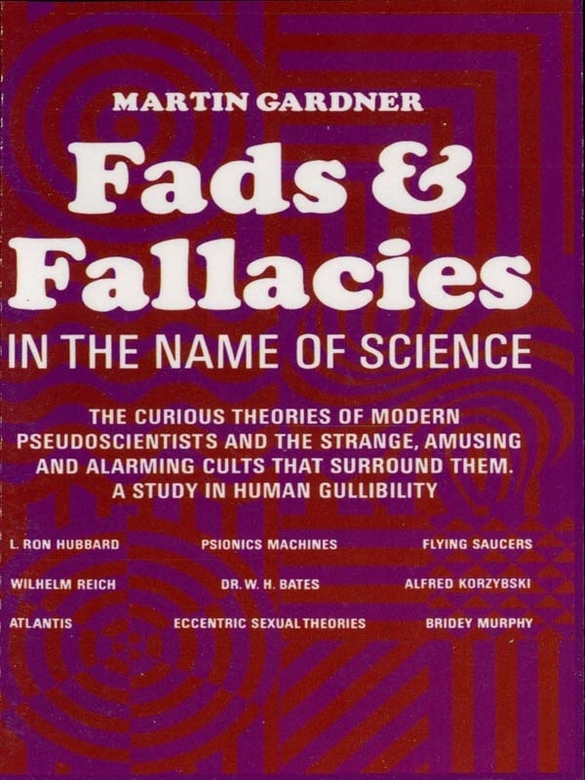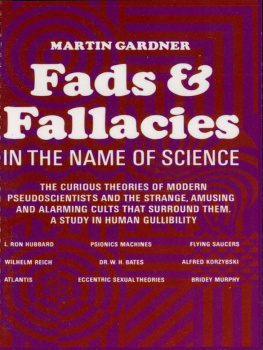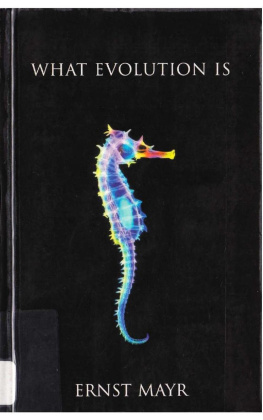
Appendix and Notes
CHAPTER 1
Notes
This point is emphasized in I. Bernard Cohens excellent paper, Orthodoxy and Scientific Progress, Proceedings of the American Philosophical Society, Oct., 1952. The same issue also contains Edwin G. Borings wise and witty lecture, The Validation of Scientific Belief, which opened the societys 1952 symposium on scientific unorthodoxies. See also L. Sprague de Camps informative article, Orthodoxy and Science, Astounding Science Fiction , May, 1954.
In 1952 a science cranks paranoia led to a senseless murder. A young war veteran and self-styled genius named Bayard P. Peakes walked one morning into the offices of the American Physical Society, Columbia University, whipped a pistol from his pocket and killed the 18-year-old stenographer whom he had never seen before. After his capture he gave his reasons. The society had refused to publish his book How to Live Forever , explaining his theory of prolonging life by electronics. He believed that if he killed someone connected with the society the publicity would win recognition for this work. In 1949 he had issued a pamphlet titled So You love Physics , distributing some 6,000 copies to scientists, including ten to Einstein. Einstein didnt answer me, Peakes told a reporter. I think hes crazy.
One of the most delightful of these inverted theories is the granular universe of Osborne Reynolds (1842-1912), professor of Engineering at Owens University, Manchester, England. On the basis of experiments with wet sand, Reynolds concluded that space was made up of solidly packed spheres, each with a diameter of one seven hundred thousand millionth part of the wave length of light. Material particles are simply bubbles of nothing, moving about in this dense, elastic, granular medium. The larger the hole in the medium the stronger the distortion in the otherwise normal piling of surrounding grains. Gravity is a pressure that results from this distortion. See his On an Inversion of Ideas as to the Structure of the Universe, 1902, and The Sub-Mechanics of the Universe, 1903, both published by Cambridge University Press.
Bertrand Russell, in his article, In the Company of Cranks, Saturday Review, Aug. 11, 1956, writes:
Experience has taught me a technique for dealing with such people. Nowadays when I meet the Ephraim-and-Manasseh devotees I say, I dont think youve got it quite right. I think the English are Ephraim and the Scotch are Manasseh. On this basis a pleasant and inconclusive argument becomes possible. In like manner, I counter the devotees of the Great Pyramid by adoration of the Sphinx; and the devotee of nuts by pointing out that hazelnuts and walnuts are just as deleterious as other foods and only Brazil nuts should be tolerated by the faithful. But when I was younger I had not yet acquired this technique, with the result that my contacts with cranks were sometimes alarming.
CHAPTER 2
Readers interested in learning more about Voliva may consult the following two articles: Croesus at the Altar, by Alfred Prowitt, American Mercury , April, 1930, and They Call Me a Flathead, by Walter Davenport, Colliers, May 14, 1927.
For historical background on Symmes hollow earth see Symmes Theory, by John W. Peck, Ohio Archeological Historical Publications , Vol. 18, 1909, p. 28; The Theory of Concentric Spheres, by William M. Miller, Isis , Vol. 33, 1941, p. 507; and The Theory of Concentric Spheres, by Conway Zirkle, Isis, Vol. 34, July, 1947.
It is interesting to note that Teed was the author of a novel about the future. It was published posthumously by his followers in 1909 under the title, The Great Red Dragon; or, The Flaming Devil of the Orient, and bearing the pseudonym of Lord Chester.
Teeds hollow earth, or a theory very similar to it, has been taken up by Duran Navarro, a Buenos Aires lawyer. According to a story in Time, July 14, 1947, Navarro contends that gravity is really centrifugal force generated by a rotating hollow earth inhabited on the inside. The force naturally diminishes as you move away from the surface toward the central point where protons and electrons come together to form fotons that in turn produce the sun. Simultaneously with Navarros announcement, Time adds, comes news from Berlin that the earth does not rotate from west to east. An accountant named Valentin Herz has proved that it really rotates the opposite way.
It was also in Germany that pseudo-science recently took a drubbing. A West German patent attorney, Godfried Bueren, boldly offered 25,000 marks (about $6,000) to anyone who could disprove his hollow sun theory. According to Herr Bueren, the suns flaming outer shell surrounds a cool inner sphere. Covered with vegetation, the dark core can be glimpsed occasionally through sunspots which are nothing more than temporary rents in the blazing shell. The German Astronomical Society carefully ripped the theory apart and when Bueren refused to pay, the society took legal action. Incredible as it may seem, the court decided in favor of the astronomers. Herr Bueren was ordered to pay the sum he had offered, plus court costs and interest. See Time , Feb. 23, 1953.
Notes
For further details concerning the German cult and other hollow earth theories see Willy Leys The Hollow Earth, Galaxy , March, 1956.
CHAPTER 3
Velikovskys second book, Ages in Chaos , Vol. I, 1952, is a drastic revision of ancient Hebrew and Egyptian history to make it conform to the authors interpretation of the Old Testament. Velikovskys historical method, as reviewer William Albright observed ( N. Y. Herald Tribune Book Review , April 20, 1952), is on a level with that of the professor who identified Moses with Middlebury by dropping the -oses and adding -iddlebury.
In 1955 Velikovskys third work, Earth in Upheaval, appeared. It defends his theory that evolution has proceeded by a series of catastrophic leaps, the catastrophes caused by comets. The book is markedly inferior in ingenuity to George Prices The New Geology (discussed in Chapter 11). Several prominent non-scientists continued to lend the dignity of their names to the doctors fantasies. I am impressed with how Dr. Velikovsky has piled up the evidence, stated Horace Kallen, and built a case for the catastrophic theory of evolution which no self-respecting man of science can disregard. And Clifton Fadiman, in the Book-of.-the-Month Club News, Dec., 1955, likened Velikovsky to Leonardo DaVinci and asserted that to charge the doctor with eccentricity was the merest obscurantism. Fadiman admitted that he himself possessed virtually no scientific training, nevertheless he thought Velikovskys thesis carried a great deal of persuasion.
One of the best of the many attacks on Velikovskys twaddle is a paper by Harvard astronomer Cecilia Payne-Gaposchkin in the Proceedings of the American Philosophical Society, Vol. 96, Oct., 1952. This paper was read at a session on scientific unorthodoxies during the 1952 meeting of the society. Velikovsky attended the session, and after the paper was read, the chairman permitted the doctor to make a rebuttal. As one present on this occasion I can report that Velikovskytall, distinguished looking, and completely at easegave a magnificent performance as the misunderstood genius, patiently resigned to the stubbornness of his orthodox critics. His chief fear, he said, was that in the future his theories might become a new dogma, as difficult to modify as the theories of present-day astronomy. Everyone applauded politely when he finished.




















